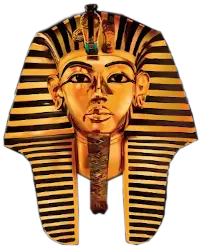
of the created Gods were given as Shu and Tefnut (Air and Moisture), Geb and Nut (Earth and Sky); and two other pairs of opposites: Osiris and Isis; and Seth and Nephthys, who are supposed to be the first creatures of this world (Frankfort's Intellectual Adventures of Man, p. 54).
Now if we compare this Egyptian cosmology with the Nebular hypothesis of Laplace, we would find very striking similarities in the two contexts. According to the Nebular hypothesis our present solar system was once a molten gaseous nebula. This nebula rotated at an enormous speed, and as the mass cooled down it also contracted and developed greater speed. The result was a bulging at the equator and a gradual breaking off of gaseous rings, which formed themselves into planets. These planets in turn threw off gaseous rings, which formed themselves into smaller bodies, until at last, the sun was left as the remnant of the original parent Nebula. From this context it is clear that the original parent nebula was fire or the Sun, and that by throwing off parts of itself, it created some planets, which in turn threw off parts of themselves and created others. According to the context of the Memphite Theology, the creator God was the Sun God or fire God Atum (Atom), who named four pairs of parts of his own body, from which Gods came forth.
But Atum (Atom) together with the Eight Created Gods composed the Ennead or Godhead of nine: a very striking similarity with modern science which teaches that there are nine major planets. We may now summarise these similarities:--(a) The creator God in both the Egyptian and Modern Cosmologies is the Sun or Fire. (b) The creator God in both cosmologies creates Gods from parts of Himself. (c) The number of Gods are nine and correspond with the nine major planets. These similarities make it evident that Laplace obtained his hypothesis from the Memphite Theology or other Egyptian sources.
Of course the Memphite Theology, according to Frankfort in his Intellectual Adventure of Ancient Man, p. 54 does not
Topics
Greek Philospohy is Stolen Egyptian Philosophy
The Memphite Theology is the Basis of all Important Doctrines of Greek Philosophy
Greek Philosophy was Alien to the Greeks
Greek Philosophy was the offspring of the Egyptian Mystery System
The Egyptians Educated the Greeks
The Curriculum of the Egyptian Mystery System
The Pre-Socratic Philosophers and the teaching Ascribed to them
The Athenian Philosophers
1. Socrates
2. Plato
3. Aristotle